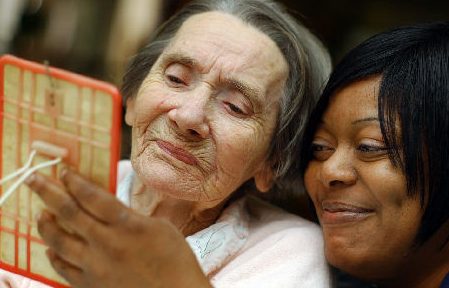
What Does Home Hospice Do?
Home hospice sends nurses, aides, therapists, volunteers, and other hospice staff to the homes of patients with a prognosis of six months or less. They help with symptom control, personal care, care planning & coordination, and emotional support. Hospice works for both patients and their entire family and caregiving unit. Hospice strives to give patients maximum comfort and quality of life and to support families in those same efforts. Would you like more details?
Symptom Control
Terminal diseases often cause high levels of fatigue, breathing pain, other bodily pain, depression, nausea, and other symptoms. The symptoms are so severe, that without hospice, they escalate month after month. Nursing services are the mainstay of most hospice programs, but physical, speech, and occupational therapists may also be available to help manage the symptoms of terminal diseases in their advanced states. This may involve medication administration & management. That can include shots, IVs, pill box set up, and/or caregiver training. Additionally, hospice sometimes provides patients with rescue kits designed with what each patient may need to manage breakthrough symptoms.
Hospice provides more than medicine for symptom control. Hospice offers other strategies for nutrition, hydration, and comfort. For instance, hospice can provide pressure relieving devices for patients who are spending more time sitting or in bed. As another example, nurses can teach family individualized strategies for recognizing and addressing dry lips or dry mouth.
Palliative Rehabilitation
People in advanced disease states tend to experience progressive levels of debility. This includes high levels of functional loss, increased dependency on family for activities of daily living, and mobility limitations. The progressive debility, in turn, contributes to a number of problems related to quality of life, and that is a primary concern of hospice. Palliative rehabilitation is defined as the process of helping a person reach the fullest physical, psychological, social, vocational, and educational potential, consistent with his or her desires and life plans. It can involve exercise therapy from physical therapists, occupational therapists, and/or speech/language pathologists. For hospice patients, energy levels can wax and wane, and physical and cognitive functions can change dramatically on a daily basis. For this reason, palliative rehabilitation shifts plans fluidly and responsively according to each patient’s daily situation.
Equipment & Supplies
Caring for a patient properly in the comfort of home often requires proper equipment and supplies. Hospice handles most of this at no extra charge to patients. They may arrange for the delivery and set-up of hospital beds, wheelchairs, bedside commodes, and all sorts of tools and equipment many people don’t think about. For instance, there is a special tray to help wash a person’s hair in bed.
Personal Care
Many hospices have professionally trained hospice aides and/or volunteers to provide various levels of personal care. In home hospice, this is usually only intermittent service consisting of two or three visits per week. In that time, hospice staff can help with errands or light housekeeping. When a patient is experiencing debilitating fatigue or other debilitating symptoms, a trained home hospice aide is very helpful in giving patients baths. Aides can help change bed sheets while a patient is still in the bed. There are a number of daily, personal care activities that become tricky during end-of-life care. Fortunately, home hospice aides are prepared for most of them.
Family Training
Without proper training, caring for a loved one with a major medical condition can be a daunting, stressful task. Family and caregiver training from the hospice staff greatly reduces caregiver stress, better enabling them to deliver care effectively and confidently. For instance, training may include how to transfer a patient from a bed to a chair in a way that is safe and comfortable for everyone involved. Nurses can train family in medications, managing a home IV, wound care, etc. Speech therapists can train family in overcoming problems with chewing or swallowing that are common in end-of-life care. Training is not limited to bodily symptoms and conditions. Hospice staff can also prepare family to help patients with the various emotions they are likely to experience.
Emotional Support
All hospice staff are highly experienced in emotional support for patients and families during this important time. Hospice programs often have nurses, social workers, and/or chaplains who will specifically make time in the care plan to discuss what to expect and healthy coping mechanisms. Even after a patient passes on, hospice makes itself available to family for at least six months.
Continuous Care
The vast majority of hospice services are delivered in a patient’s home. Hospice staff makes intermittent visits lasting thirty minutes to two hours depending on what they are doing. This tends to be all that is needed and all patients and families want. However, when more is needed, many home hospice programs have solutions. Hospice may also provide home nursing for hours at a time, and even overnight. Nurses refer to this as continuous care. If a patient’s symptoms are out of control, a nurse may stay in the home for hours until the symptoms are managed. Also, if a patient is actively dying and the family needs support, a hospice nurse may stay overnight. Not all families and patients need continuous care during this time. In fact, hospice can prepare most families for the passing of a loved one. After being well prepared, many families prefer not to have a nursing visit at time of death.
Inpatient Care
Similarly, when hours of continuous care at home are not enough, many hospice programs have arranged for inpatient respite and general inpatient care. Caring for a loved one with high personal care needs takes a physical and emotional toll on the caregiver. On occasion, the family caregiver will need more of a break than that provided by the visits of nurses, aides, and volunteers. In these cases, the hospice provider can check a patient into a 24-hour personal care home that is staffed for hospice patients. If a hospice patient has a medical need where inpatient treatment would be more appropriate than home nursing, patients can always be admitted to a hospital or nursing home of their choice. If the medical need is related to the hospice diagnosis, the hospice benefit will continue to pay the bills. Other medical needs would be covered as normal. When patients are stable enough, they can return to the comfort of home and continue their home hospice service.
Advanced Care Planning
Hospice also takes time to help patients plan for and arrange care that will be consistent with their values, even if there comes a moment when patients cannot speak for themselves. A number of instruments should be considered. These may include, a Diminishing Capacity Letter, Durable Power of Attorney, Living Wills, DNRs, DNIs, etc. Hospice helps patients navigate these contingencies and decisions.
Conclusion – What Does Hospice Do?
Amazingly, this is only a general overview of some of the ways hospice helps patients and families. If you or someone you care for may need hospice in the next year, go ahead and contact a hospice agency near you. They will often send a nurse to discuss the hospice services that would be relevant to your individual situation and to discuss when to start thinking about enrolling in hospice.





